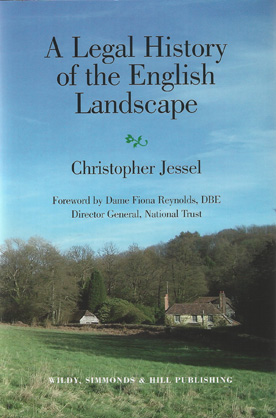
Foreword by Dame Fiona Reynolds, DBE, Director General, National Trust
A Legal History of the English Landscape is an engaging account of how the law has played a pivotal role in shaping the English landscape through the concepts of security, inheritance, dispute resolution and transfer of land.
Taking a broadly chronological approach, the book begins with the origins of legal communities in prehistory. The Romans introduced roads, towns and legal procedures to decide disputes. The Anglo-Saxon period saw great changes in the countryside with the spread of monasteries, the creation of a system of farming in open fields and the development of charters and courts to regulate them.
The book considers the Domesday Book and the introduction by the Normans of the idea of tenure which still forms the basis of our land law. In the high Middle Ages towns and cathedrals were made possible because of legal ideas such as corporations and the development of legal procedures. As wealth spread, people other than the aristocracy and churchmen became able to obtain such security that an Englishman’s home became his castle through procedures worked out in the courts and this security encouraged ordinary folk to invest money in building substantial houses.
The idea of property became important at the time of the Civil Wars. After the Restoration in 1660 the squires controlled the countryside through their landed estates. They cooperated with commercial farmers to enclose much of the land previously comprised in the open fields as well as much common land. This was authorised by Parliament which also conferred powers to make new roads, canals and railways. Industry developed mainly under private arrangements as did towns and the book examines how nineteenth-century, middle-class housing estates were organised and financed.
In the twentieth century the state intervened to modify existing rights to land by regulating leases and by the planning system. The account concludes with a view of the modern law in an age of public access to land, environmental laws and European legislation.
There are descriptions of several legal cases illustrating the way the law worked, from a lawsuit between two Roman citizens about a wood to leading cases of the nineteenth century. As conditions changed, once-important laws became obsolete and the author shows how later generations were able to adapt or circumvent them for their own needs.
A Legal History of the English Landscape aims to set land law in a wider context of changes in society and of ideas such as what it means to describe someone as owner of land and how it comes about that Parliament has the power to rearrange the landscape.
"how I wish this book had been available when I began studying law...Christopher Jessel describes the changing social, commercial and political nature of society and shows how the law has responded. Thus you have not only the 'what', but also the 'how' and 'why'. What is more, he presents it in an engaging, narrative style. There is so much to recommend this book. It is outstanding value...it sheds a fresh light on the ancient for the benefit of the modern and will inform particularly those involved in administering trusts and what remains of settlements but more generally anyone dealing with the law of the land"
Geoff Whittaker, ALA Bulletin
The book has pride of place in our bookcase
Phillip Taylor, Richmond Green Chambers